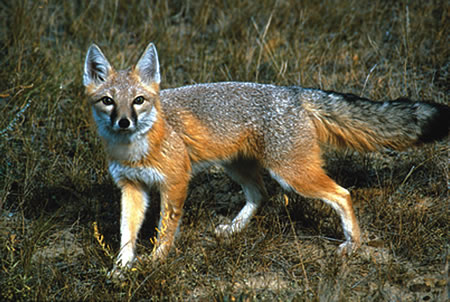Math 2423 (Calculus II)
Spring 2010

Math 2423 (Calculus II)Spring 2010 |
 |
Swift Fox (Vulpes velox). The swift fox, a smaller cousin of the common red fox, is a native of the grasslands of North America. Its range, which once extended from Texas to Saskatchewan, has been reduced to less than half of its historical extent, but the swift fox is still fairly common in parts of the Great Plains, including the Oklahoma panhandle. For more about the swift fox, see this USDA pamphlet. |
Teaching Assistants:
The TA's leading the discussion sections for this class are Houssein El Turkey, Wei Guan, and Nancy Ho. They also will be in the Mathematics Help Center on the fourth floor of the Physical Sciences Center (PHSC 425A), according to the following schedule:
You can visit any of them in the Help Center; regardless of whose discussion sections you're in. In fact, even when Houssein, Wei, or Nancy aren't there, you can still walk into the Help Center anytime it's open and get assistance from the math graduate students on duty. This semester the Help Center is open on Mondays from 9:30 am to 5:00 pm, on Wednesdays and Fridays from 9:30 am to 5:30 pm, and on Tuesdays and Thursdays from 9:00 am to 5:30 pm.
Another resource available to you is the Math Lab located in the Housing Learning Center in Adams Residence Hall, Muldrow Tower, first floor lounge. Call 325-2452 for hours of operation.
Assignment |
Due Week of |
Problems |
| 1 | Jan. 27, 28 | 5.2 #1, 2, 35, 36, 52; 5.3 #3, 10, 13, 29, 31. |
| 2 | Feb. 3, 4 | 5.4 #1, 23, 30, 35, 37; 5.5 #9, 12, 16, 17, 30. |
| 3 | Feb. 10, 11 | 5.5 #25, 27, 28, 39, 47, 48; 6.1 #10, 11, 12, 19. |
| 4 | Feb. 17, 18 | 6.2 #2, 3, 8, 9, 11, 16; 6.3 #3, 4, 6, 11. |
| 5 | Feb. 24, 25 | 6.4 #1, 19, 22, 24. |
| 6 | Mar. 3, 4 | 7.2 #32, 35, 36, 38, 39, 61, 73, 74, 76, 80. |
| 7 | Mar. 10, 11 | 7.3 #25, 26, 61; 7.4 #3, 4, 10, 22, 70, 75, 78. |
| 8 | Mar. 24, 25 | 7.4 (p. 420) #44, 49, 50; 7.6 #5, 7, 22, 23, 24, 30. |
| 9 | Mar. 31, Apr. 1 | 7.5 #12; 7.8 #8, 15, 19, 21, 27, 96; 8.1 #3, 4, 10. |
| 10 | Apr. 7, 8 | 8.2 #2, 3, 4, 8, 9 |
| 11 | Apr. 14, 15 | 8.2 #23, 25, 27, 35, 47, 57; 8.3 #4, 5, 8, 10 |
| 12 | Apr. 21, 22 | 8.3 #23, 24, 35; 8.4 #7, 9, 12, 19, 32, 52, 62 |
| 13 | Apr. 28, 29 | 8.4 #28, 29; 8.8 #5, 9, 21, 27, 32, 39; 9.1 #1, 3 |
| 14 | May 5, 6 | 9.1 #13; 9.2 #5, 12 (hint: do the integral with respect to y, not x); 9.3 #25, 27, 28, 29 |
The name of the ancient Greek mathematician Archimedes has come up several times in our class this semester. For example, he was, I believe, the first person ever to compute the volume of sphere, as well as the first to compute the surface area of a sphere. Here is a fascinating website devoted to him, created by Prof. Chris Rorres. For a scholarly article on the question of who discovered how to compute the volume of a sphere (the problem may have been considered, but not solved, by the ancient Babylonians and/or Chinese before Archimedes): see "On the volume of a sphere" by A. Seidenberg in Archive for History of Exact Sciences, Vol. 39, No. 2, June 1988, pages 97-119. See also this webpage titled Archimedes on Spheres and Cylinders.
Another mathematician whose name has come up several times in the course is Leonhard Euler, who lived in the 18th century. Besides being a great and prolific researcher, Euler was also a great expositor, taking care to write up his results in easily understandable form. You can find many of his papers, both in the Latin original and in English translation, online at The Euler Archive.
Here is a link to the math blog at the New York Times which I mentioned in class: http://opinionator.blogs.nytimes.com/category/steven-strogatz.